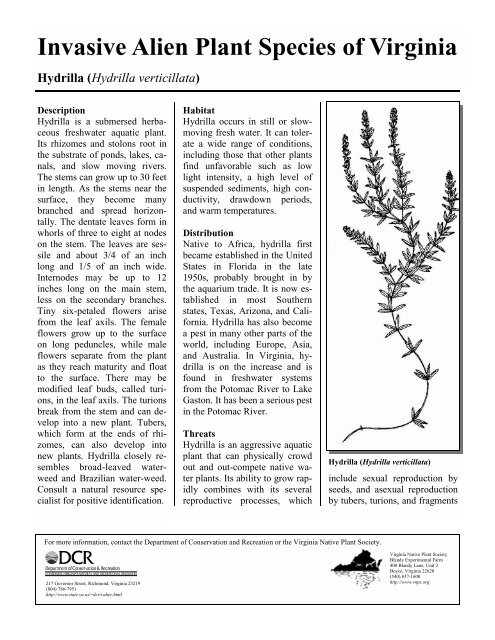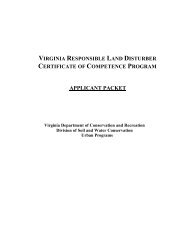Invasive Alien Plant Species of Virginia Hydrilla (Hydrilla verticillata)
Invasive Alien Plant Species of Virginia Hydrilla (Hydrilla verticillata)
Invasive Alien Plant Species of Virginia Hydrilla (Hydrilla verticillata)
You also want an ePaper? Increase the reach of your titles
YUMPU automatically turns print PDFs into web optimized ePapers that Google loves.
<strong>Invasive</strong> <strong>Alien</strong> <strong>Plant</strong> <strong>Species</strong> <strong>of</strong> <strong>Virginia</strong><br />
Alligatorweed <strong>Hydrilla</strong> (<strong>Hydrilla</strong> (Alternanthera <strong>verticillata</strong>) philoxeroides)<br />
Description<br />
<strong>Hydrilla</strong> is a submersed herbaceous<br />
freshwater aquatic plant.<br />
Its rhizomes and stolons root in<br />
the substrate <strong>of</strong> ponds, lakes, canals,<br />
and slow moving rivers.<br />
The stems can grow up to 30 feet<br />
in length. As the stems near the<br />
surface, they become many<br />
branched and spread horizontally.<br />
The dentate leaves form in<br />
whorls <strong>of</strong> three to eight at nodes<br />
on the stem. The leaves are sessile<br />
and about 3/4 <strong>of</strong> an inch<br />
long and 1/5 <strong>of</strong> an inch wide.<br />
Internodes may be up to 12<br />
inches long on the main stem,<br />
less on the secondary branches.<br />
Tiny six-petaled flowers arise<br />
from the leaf axils. The female<br />
flowers grow up to the surface<br />
on long peduncles, while male<br />
flowers separate from the plant<br />
as they reach maturity and float<br />
to the surface. There may be<br />
modified leaf buds, called turions,<br />
in the leaf axils. The turions<br />
break from the stem and can develop<br />
into a new plant. Tubers,<br />
which form at the ends <strong>of</strong> rhizomes,<br />
can also develop into<br />
new plants. <strong>Hydrilla</strong> closely resembles<br />
broad-leaved waterweed<br />
and Brazilian water-weed.<br />
Consult a natural resource specialist<br />
for positive identification.<br />
Habitat<br />
<strong>Hydrilla</strong> occurs in still or slowmoving<br />
fresh water. It can tolerate<br />
a wide range <strong>of</strong> conditions,<br />
including those that other plants<br />
find unfavorable such as low<br />
light intensity, a high level <strong>of</strong><br />
suspended sediments, high conductivity,<br />
drawdown periods,<br />
and warm temperatures.<br />
Distribution<br />
Native to Africa, hydrilla first<br />
became established in the United<br />
States in Florida in the late<br />
1950s, probably brought in by<br />
the aquarium trade. It is now established<br />
in most Southern<br />
states, Texas, Arizona, and California.<br />
<strong>Hydrilla</strong> has also become<br />
a pest in many other parts <strong>of</strong> the<br />
world, including Europe, Asia,<br />
and Australia. In <strong>Virginia</strong>, hydrilla<br />
is on the increase and is<br />
found in freshwater systems<br />
from the Potomac River to Lake<br />
Gaston. It has been a serious pest<br />
in the Potomac River.<br />
Threats<br />
<strong>Hydrilla</strong> is an aggressive aquatic<br />
plant that can physically crowd<br />
out and out-compete native water<br />
plants. Its ability to grow rapidly<br />
combines with its several<br />
reproductive processes, which<br />
<strong>Hydrilla</strong> (<strong>Hydrilla</strong> <strong>verticillata</strong>)<br />
include sexual reproduction by<br />
seeds, and asexual reproduction<br />
by tubers, turions, and fragments<br />
For more information, contact the Department <strong>of</strong> Conservation and Recreation or the <strong>Virginia</strong> Native <strong>Plant</strong> Society.<br />
217 Governor Street, Richmond, <strong>Virginia</strong> 23219<br />
(804) 786-7951<br />
http://www.state.va.us/~dcr/vaher.html<br />
<strong>Virginia</strong> Native <strong>Plant</strong> Society<br />
Blandy Experimental Farm<br />
400 Blandy Lane, Unit 2<br />
Boyce, <strong>Virginia</strong> 22620<br />
(540) 837-1600<br />
http://www.vnps.org
<strong>Invasive</strong> <strong>Alien</strong> <strong>Plant</strong> <strong>Species</strong> <strong>of</strong> <strong>Virginia</strong><br />
<strong>Hydrilla</strong> (<strong>Hydrilla</strong> <strong>verticillata</strong>)<br />
<strong>of</strong> plant parts. The plant forms<br />
dense clumps <strong>of</strong> vegetation that<br />
can clog boat propellers and impede<br />
navigation, shade light<br />
from beneficial plants, provide<br />
habitat for noxious insects such<br />
as mosquitoes, clog water intakes,<br />
and remove oxygen from<br />
the water as dead plant matter<br />
decays.<br />
Control<br />
Accurate identification <strong>of</strong> hydrilla<br />
by a resource specialist<br />
should precede control efforts. If<br />
a new site is discovered, it<br />
should be reported to appropriate<br />
<strong>of</strong>ficials. Because <strong>of</strong> the great<br />
economic impact <strong>of</strong> this noxious<br />
weed, control efforts have been<br />
heavily researched and widely<br />
applied. These efforts include<br />
chemical control through herbicides,<br />
biological control using<br />
introduced natural predators, and<br />
mechanical harvesting and destruction<br />
efforts. Studies have<br />
identified effective chemicals,<br />
but there are concerns about<br />
their impact on the environment.<br />
Biological control organisms<br />
studied include insects, grass<br />
carp, snail species, manatees,<br />
and fungi species. Grass carp,<br />
an exotic fish species, can be effective,<br />
but may become a pest<br />
themselves. Mechanical harvesting<br />
will reduce infestations in<br />
the short term and are used to<br />
keep waterways and marinas<br />
open. However, if the fragments<br />
are not contained, they can also<br />
float away and establish new<br />
colonies elsewhere.<br />
For more information on native<br />
plant conservation, contact<br />
the <strong>Virginia</strong> Native <strong>Plant</strong> Society<br />
at the address below. For information<br />
on <strong>Virginia</strong>'s natural areas<br />
and natural heritage resources,<br />
contact the <strong>Virginia</strong> Department<br />
<strong>of</strong> Conservation and<br />
Recreation's Division <strong>of</strong> Natural<br />
Heritage (see address below).<br />
Written with assistance from<br />
Ruth Douglas and Laura Peters<br />
at <strong>Virginia</strong> Polytechnic and<br />
State University.<br />
Illustration from Field Guide to<br />
Coastal Wetland <strong>Plant</strong>s <strong>of</strong> the Southeastern<br />
United States, by Ralph Tiner,<br />
University <strong>of</strong> Massachusetts Press.<br />
12/97<br />
For more information, contact the Department <strong>of</strong> Conservation and Recreation or the <strong>Virginia</strong> Native <strong>Plant</strong> Society.<br />
217 Governor Street, Richmond, <strong>Virginia</strong> 23219<br />
(804) 786-7951<br />
http://www.state.va.us/~dcr/vaher.html<br />
<strong>Virginia</strong> Native <strong>Plant</strong> Society<br />
Blandy Experimental Farm<br />
400 Blandy Lane, Unit 2<br />
Boyce, <strong>Virginia</strong> 22620<br />
(540) 837-1600<br />
http://www.vnps.org
















